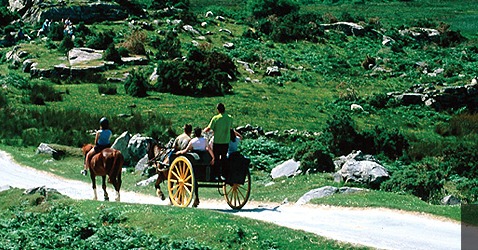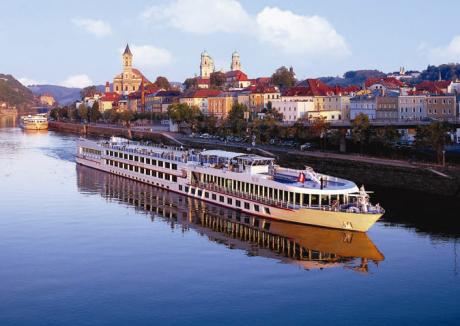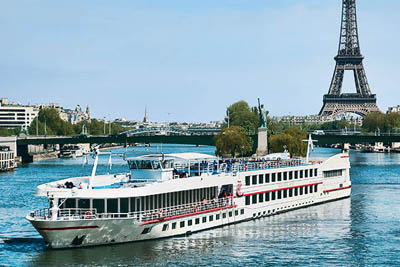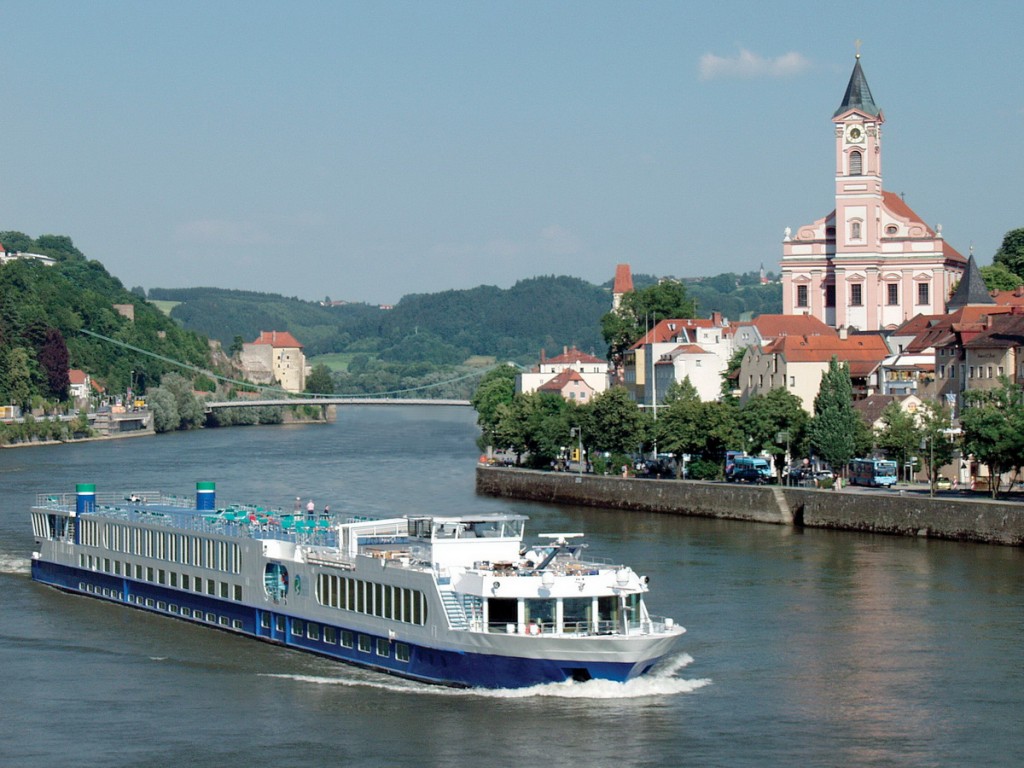The climate clamor over flying doesn’t stop with environmental activists. One British bishop denounced flying on a vacation as a “sin.” Even publishers of travel books lament the climate impact of their wanderlust guides and are advising travelers to “fly less and stay longer.” Mark Ellingham, founder of Rough Guides, and Tony Wheeler, founder of Lonely Planet, have decried the growth of what they call “binge flying,” and urged air travelers to take to the skies less often. “In Europe, and especially Britain, we have become addicted to cheap flights, heading off to Rome for the day or Prague for the weekend,” writes Ellingham in e-mail. “Many people buy these as casually as booking a restaurant. I consider this ‘binge flying’ and I don’t think it’s sustainable behavior.”
How worried should air travelers be about contributing to global warming? Flying still makes up a very small percentage of greenhouse gas emissions. Globally, just 1.5 percent of greenhouse gas emissions caused by human activity each year come from air travel, according to Tim Herzog, a climate policy analyst for the World Resources Institute. In the U.S., that number’s about 3.5 percent. Yet those numbers are projected to rise sharply, making air travel one of the fastest growing contributors to global warming, while the world is struggling to reduce emissions. Over the next 20 years, more than 27,000 new aircraft will take flight, and the number of air travelers will double to 9 billion during the same period, according to the Hodgkinson Group, an aviation consulting firm. Here in the United States in the next two decades, demand for air travel will grow 150 percent, according to the Department of Energy.
Some governments are stepping in to curb the rising tide of emissions. By 2011, airplanes traveling within the European Union will be subject to a carbon trading scheme. But debate about such regulations inspired the unrepentant boss of one low-cost airline, Ryanair, to pledge to increase his company’s carbon emissions, saying if his customers are worried about the environment, he had some advice for them: “Sell your car and walk.”
Hopping a commercial flight sure feels like an airborne form of carpooling, especially when the blowhard sitting next to you won’t close his yapping trap for six hours. And, sure, fine, it’s unquestionably better for the environment than owning a private jet, which one horrified activist compared to buying a whole coal-fired power plant to power a single mobile phone. Yet even on today’s full flights with passengers crammed into small seats, flying packs a big climate punch. For a long trip, like a transatlantic flight on an average-size plane, each passenger is responsible for sending .39 pounds of CO2 per mile into the atmosphere, according to the World Resources Institute’s Greenhouse Gas Protocol Initiative. By that measure, flying direct from Denver to London and back puts about 3,600 pounds of CO2 into the atmosphere, equivalent to driving a Toyota Prius hybrid 10,000 miles.
While most Americans still emit more by driving than flying, simply because they spend so many hours in the car, frequent fliers can spew a lot more emissions than daily commuters. Take the doting grandmother, recently profiled in the New York Times, who flies 500 miles a week, jetting from her home in Houston to Dallas and back to care for her grandkids, a tale the paper dubbed “The Incredible Flying Granny Nanny.” A year of this high-flying childcare arrangement will pump almost 16,500 pounds of C02 into the atmosphere, more than the average driver of a four-wheel-drive Ford Ranger emits in a year.
It may be a short flight from Houston to Dallas, but shorter flights have a larger impact per mile than longer ones, since the takeoff and landing are the most fuel-hungry part of the journey. “These regional flights are not efficient because they don’t have time to get up into the atmosphere and cruise, where jets are most efficient,” says Luke Tonachel, a vehicles and fuels analyst for the Natural Resources Defense Council. That means the Incredible Flying Granny emits .63 pounds per mile every time she jumps on a jet to see the grandkids. She could reduce her emissions by hopping behind the wheel of a Honda Civic by herself and driving from Houston to Dallas and back.
But why pick on one grandma, when business travel accounts for 65 percent of all flights in the United States, according to PhoCusWright, a travel research firm. It’s the management consultants jetting from New York to Kansas City, and the tech executives winging it from Silicon Valley to the Bangalore outpost, who are really racking up those airborne emissions. Just ask Tom Arnold, chief environmental officer for TerraPass, a Silicon Valley company that sells carbon offsets: “The overwhelming majority of my personal carbon footprint is flights,” he says. Arnold says he cuts down by consolidating trips, and staying four or five days when he goes on a cross-country trip to New York, instead of just flying in for a meeting or two.
Flying also has another warming effect, beyond the greenhouse gas emissions. Planes leave behind contrails, thin wisps of condensation in their wake, which act like high, thin ice clouds producing an effect called “radiative forcing.” The contrails trap heat that’s radiating off the earth’s surface, contributing to global warming. During the day, they also reflect sunlight, which has a counterbalancing cooling effect. At night, and during the winter, when its darker, there’s less sunlight for the clouds to block. “The warming effect goes on 24 hours,” says Don Wuebbles, a professor of atmospheric science and director of the School of Earth, Society and Environment at the University of Illinois. “It’s generally thought that the warming effect wins out. The cooling effect is only during the day.” Right after 9/11, when most planes were grounded in the United States for days, scientists were able to measure a change in the temperature.
A purist might argue that if you’re really worried about global warming, any recreational flying is unsustainable. As with so much else with global warming, the emissions math is not that straightforward. Deforestation is a major contributor to global warming — second only to power generation as a source around the world — accounting for some 18 percent of annual human-induced greenhouse gas emissions. Tourism is one of the key industries that makes it economically viable for poorer countries to avoid clear-cutting rain forests for cattle ranching or agriculture. If visitors from richer countries suddenly stopped flying, more rain forests would fall, creating more emissions.
“I don’t think it would be a great thing for the world — and the developing world especially — if we all stopped flying entirely,” writes Ellingham from Rough Guides. “What is crucial, however, is that aviation doesn’t continue to grow at present rates — 10 percent in the U.K. and more than 5 percent globally. We don’t have a God-given right to cheap flights that overrides our responsibility to the planet and its people, most of whom, of course, never get on an aeroplane.”
It may come as a surprise to learn the airline industry itself is talking green. In June, Giovanni Bisignani, director general and CEO of the International Air Transport Association, threw down the gauntlet to his colleagues in the airline industry at their annual meeting. “Air transport must become an industry that does not pollute. Zero emissions,” he said. How to get there? “I don’t have all the answers, but our industry started with a vision that we could fly. The Wright brothers turned that dream into reality and look at where we are now.b
The association issued a challenge to its members to replace 10 percent of their polluting fossil fuel with low-carbon alternatives within the decade, and called on the airline manufacturers to build a zero-emissions aircraft within the next 50 years. The U.S. Air Force has set an even more ambitious goal, challenging fuel refiners and alternative energy companies to move the Air Force’s entire fleet to fuel that’s only 50 percent petroleum-based within the next decade. In the meantime, there’s an air travel industry-based Web site to soothe public fears about climate change and flying.
Richard Branson, maverick founder of Virgin Atlantic, has pledged $3 billion to search for alternative fuels. Biofuels don’t pack as much energy per unit as fossil fuels, which makes it challenging to use them aloft. There’s also some concern about them freezing or gumming up at high altitudes. Nevertheless, Virgin claims that it will be ready to test an alternative fuel on a commercial jet in 2008. In the meantime, the race is on to be more efficient with conventional fuels. Boeing boasts that its forthcoming 787 Dreamliner will use 20 percent less fuel than similar-size planes flying today. And one low-cost carrier, EasyJet, has a prototype for a short-haul jet that will reduce CO2 emissions by half.
To conserve fuel, Virgin Airways has experimented with towing airplanes to the runway to avoid turning their engines on until the last possible second. In fact, many planes now taxi with just one engine on, instead of using both, according to Steve Lott, a spokesman for the International Air Transport Association. Better air traffic management to ensure that planes take the shortest routes to their destinations and spend less time circling above airports waiting to land could also yield significant efficiency savings, according to Lott.
Yet these glimmers of conservation don’t appease Joel Makower, executive editor of Greenbiz.com, an environmental consultant to Fortune 500 companies. He recently mused on his blog about whether air travel will ever be green. “I don’t see anything that’s being done by the industry that suggests that airplane travel is going to be climate-friendly within my lifetime,” says Makower, who flew 51 times in the first half of 2007. He argues that the projected growth of the industry and current state of technology mean that airline emissions simply will get worse before they get better.
Still, without an obvious technology fix for air travel, inspiring passengers to give up flying is like trying to toss a paper airplane through a hurricane. Sure, a business traveler can replace a shuttle flight from New York to Boston with a more efficient train ride, but most trips, at least in the U.S., don’t offer such an obvious, efficient and convenient alternative to flying. “If you’re traveling on business between Atlanta and Chicago, what else are you going to do?” asks Herzog from the World Resources Institute. Makower says he hasn’t seen companies voluntarily replacing far-flung meetings with videoconferencing to curtail flying. “Some companies recognize that air travel is the biggest part of their carbon footprint, and the typical response is to offset it, not to reduce it,” he says. Even Ellingham from Rough Guides admits that asking people to cut back on flying won’t achieve much. “I think that a lot of people are moderating their flying habits, and many more will do so as the facts and urgency of acting on climate change become clear. But, no, I don’t think that it will be enough unless governments intervene.” Currently, the European Union’s plans to implement a carbon emissions trading scheme for airlines in 2011 is the only such action.
If you’re trying to figure out the impact of your own flight, you can use many online calculators, mostly presented by companies selling carbon offsets. Be forewarned that the results represent rough approximations. Also, each calculator makes somewhat different assumptions about how big the average plane is, how efficient it is and how full of passengers it is, and so your results will vary. Most online calculators don’t attempt to include the added impact of contrails.
The best way to reduce air travel emissions is, of course, not to fly. If a train is available and efficient, it’s always a better option, according to Jennifer Hattam, green lifestyles expert for the Sierra Club. She also recommends limiting shorter vacations to spots close to home, while saving flying for longer journeys. Another tip: Horde all your vacation days to take one long holiday instead of several shorter vacations throughout the year, involving flying.
Although you won’t catch anyone at the Sierra Club telling you to jump in a car, driving can produce fewer emissions per passenger mile than flying, especially if you have a fuel-efficient car. Trying to decide if you should drive or fly from, say, San Francisco to Los Angeles, adding people to your car who would have flown can easily tip the scales in favor of driving. Flying in the summer, when there’s more light, is also better for the atmosphere than flying in the winter, when it’s darker. And now that you know it’s better to fly in the day, you have a perfect excuse, should your eco-savvy boss want you to be in your transcontinental office the next morning, not to take the red-eye.









 If you’d like to learn more about guided tours, please give me a call. I have favorites around the world that I’d love to tell you about. Or if you’d like to do a bit more reading, the following are guided tour companies I regularly recommend;
If you’d like to learn more about guided tours, please give me a call. I have favorites around the world that I’d love to tell you about. Or if you’d like to do a bit more reading, the following are guided tour companies I regularly recommend;








 As summer comes to a close and cooler nights begin to emerge, many of you may be turning your thoughts to Winter and Spring travel. If you’re ready to plan a vacation, but are feeling overwhelmed at the prospect of planning something memorable, a
As summer comes to a close and cooler nights begin to emerge, many of you may be turning your thoughts to Winter and Spring travel. If you’re ready to plan a vacation, but are feeling overwhelmed at the prospect of planning something memorable, a  Local specialties and International cuisine are offered daily on board the ships, while trips to area markets and renowned restaurants provide an authentic experience.
Local specialties and International cuisine are offered daily on board the ships, while trips to area markets and renowned restaurants provide an authentic experience.